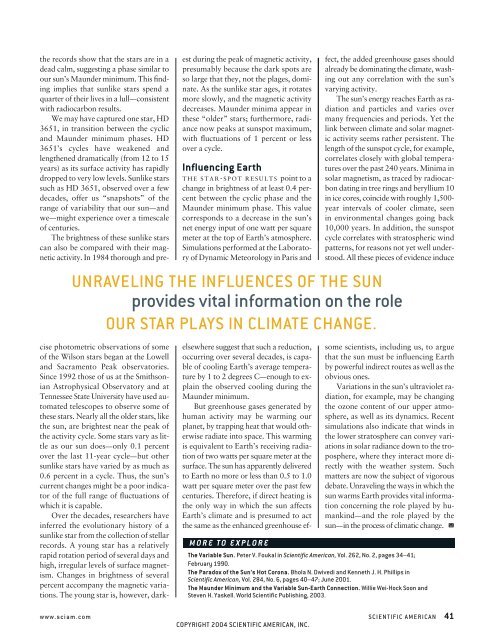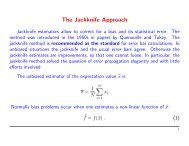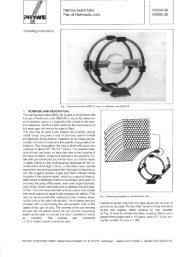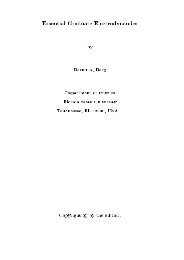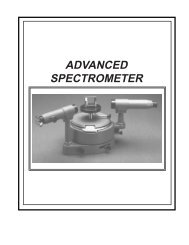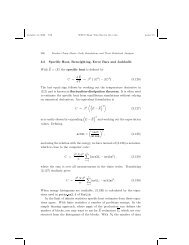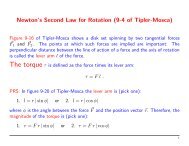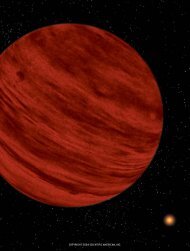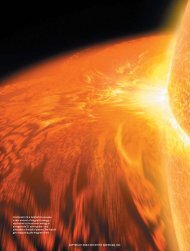The Stellar Dynamo - Scientific American Digital
The Stellar Dynamo - Scientific American Digital
The Stellar Dynamo - Scientific American Digital
- No tags were found...
Create successful ePaper yourself
Turn your PDF publications into a flip-book with our unique Google optimized e-Paper software.
cise photometric observations of some<br />
of the Wilson stars began at the Lowell<br />
and Sacramento Peak observatories.<br />
Since 1992 those of us at the Smithsonian<br />
Astrophysical Observatory and at<br />
Tennessee State University have used automated<br />
telescopes to observe some of<br />
these stars. Nearly all the older stars, like<br />
the sun, are brightest near the peak of<br />
the activity cycle. Some stars vary as little<br />
as our sun does—only 0.1 percent<br />
over the last 11-year cycle—but other<br />
sunlike stars have varied by as much as<br />
0.6 percent in a cycle. Thus, the sun’s<br />
current changes might be a poor indicator<br />
of the full range of fluctuations of<br />
which it is capable.<br />
Over the decades, researchers have<br />
inferred the evolutionary history of a<br />
sunlike star from the collection of stellar<br />
records. A young star has a relatively<br />
rapid rotation period of several days and<br />
high, irregular levels of surface magnetism.<br />
Changes in brightness of several<br />
percent accompany the magnetic variations.<br />
<strong>The</strong> young star is, however, darkest<br />
during the peak of magnetic activity,<br />
presumably because the dark spots are<br />
so large that they, not the plages, dominate.<br />
As the sunlike star ages, it rotates<br />
more slowly, and the magnetic activity<br />
decreases. Maunder minima appear in<br />
these “older” stars; furthermore, radiance<br />
now peaks at sunspot maximum,<br />
with fluctuations of 1 percent or less<br />
over a cycle.<br />
Influencing Earth<br />
THE STAR-SPOT RESULTS point to a<br />
change in brightness of at least 0.4 percent<br />
between the cyclic phase and the<br />
Maunder minimum phase. This value<br />
corresponds to a decrease in the sun’s<br />
net energy input of one watt per square<br />
meter at the top of Earth’s atmosphere.<br />
Simulations performed at the Laboratory<br />
of Dynamic Meteorology in Paris and<br />
elsewhere suggest that such a reduction,<br />
occurring over several decades, is capable<br />
of cooling Earth’s average temperature<br />
by 1 to 2 degrees C—enough to explain<br />
the observed cooling during the<br />
Maunder minimum.<br />
But greenhouse gases generated by<br />
human activity may be warming our<br />
planet, by trapping heat that would otherwise<br />
radiate into space. This warming<br />
is equivalent to Earth’s receiving radiation<br />
of two watts per square meter at the<br />
surface. <strong>The</strong> sun has apparently delivered<br />
to Earth no more or less than 0.5 to 1.0<br />
watt per square meter over the past few<br />
centuries. <strong>The</strong>refore, if direct heating is<br />
the only way in which the sun affects<br />
Earth’s climate and is presumed to act<br />
the same as the enhanced greenhouse effect,<br />
the added greenhouse gases should<br />
already be dominating the climate, washing<br />
out any correlation with the sun’s<br />
varying activity.<br />
<strong>The</strong> sun’s energy reaches Earth as radiation<br />
and particles and varies over<br />
many frequencies and periods. Yet the<br />
link between climate and solar magnetic<br />
activity seems rather persistent. <strong>The</strong><br />
length of the sunspot cycle, for example,<br />
correlates closely with global temperatures<br />
over the past 240 years. Minima in<br />
solar magnetism, as traced by radiocarbon<br />
dating in tree rings and beryllium 10<br />
in ice cores, coincide with roughly 1,500-<br />
year intervals of cooler climate, seen<br />
in environmental changes going back<br />
10,000 years. In addition, the sunspot<br />
cycle correlates with stratospheric wind<br />
patterns, for reasons not yet well understood.<br />
All these pieces of evidence induce<br />
UNRAVELING THE INFLUENCES OF THE SUN<br />
provides vital information on the role<br />
OUR STAR PLAYS IN CLIMATE CHANGE.<br />
the records show that the stars are in a<br />
dead calm, suggesting a phase similar to<br />
our sun’s Maunder minimum. This finding<br />
implies that sunlike stars spend a<br />
quarter of their lives in a lull—consistent<br />
with radiocarbon results.<br />
We may have captured one star, HD<br />
3651, in transition between the cyclic<br />
and Maunder minimum phases. HD<br />
3651’s cycles have weakened and<br />
lengthened dramatically (from 12 to 15<br />
years) as its surface activity has rapidly<br />
dropped to very low levels. Sunlike stars<br />
such as HD 3651, observed over a few<br />
decades, offer us “snapshots” of the<br />
range of variability that our sun—and<br />
we—might experience over a timescale<br />
of centuries.<br />
<strong>The</strong> brightness of these sunlike stars<br />
can also be compared with their magnetic<br />
activity. In 1984 thorough and pre-<br />
MORE TO EXPLORE<br />
some scientists, including us, to argue<br />
that the sun must be influencing Earth<br />
by powerful indirect routes as well as the<br />
obvious ones.<br />
Variations in the sun’s ultraviolet radiation,<br />
for example, may be changing<br />
the ozone content of our upper atmosphere,<br />
as well as its dynamics. Recent<br />
simulations also indicate that winds in<br />
the lower stratosphere can convey variations<br />
in solar radiance down to the troposphere,<br />
where they interact more directly<br />
with the weather system. Such<br />
matters are now the subject of vigorous<br />
debate. Unraveling the ways in which the<br />
sun warms Earth provides vital information<br />
concerning the role played by humankind—and<br />
the role played by the<br />
sun—in the process of climatic change.<br />
<strong>The</strong> Variable Sun. Peter V. Foukal in <strong>Scientific</strong> <strong>American</strong>, Vol. 262, No. 2, pages 34–41;<br />
February 1990.<br />
<strong>The</strong> Paradox of the Sun’s Hot Corona. Bhola N. Dwivedi and Kenneth J. H. Phillips in<br />
<strong>Scientific</strong> <strong>American</strong>, Vol. 284, No. 6, pages 40–47; June 2001.<br />
<strong>The</strong> Maunder Minimum and the Variable Sun-Earth Connection. Willie Wei-Hock Soon and<br />
Steven H. Yaskell. World <strong>Scientific</strong> Publishing, 2003.<br />
www.sciam.com SCIENTIFIC AMERICAN 41<br />
COPYRIGHT 2004 SCIENTIFIC AMERICAN, INC.


